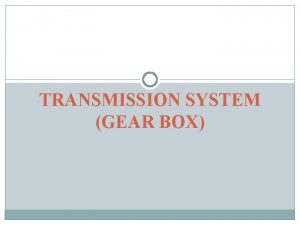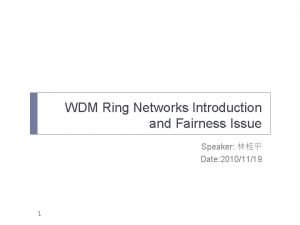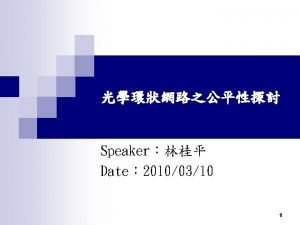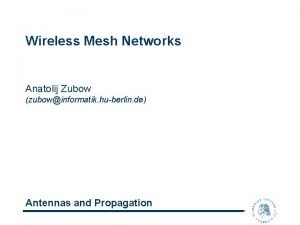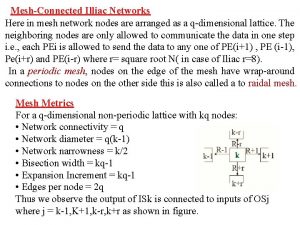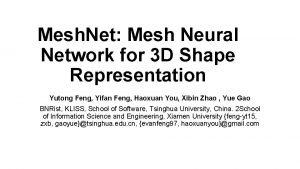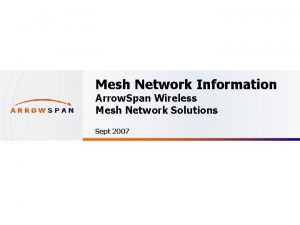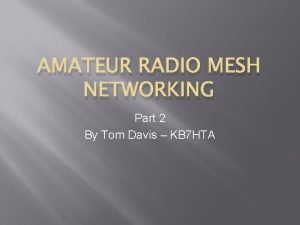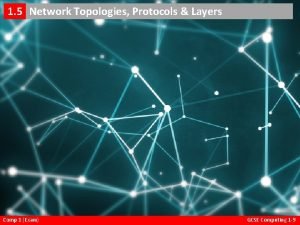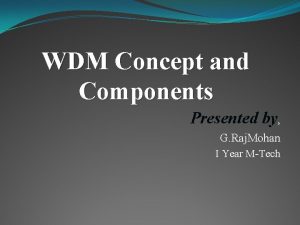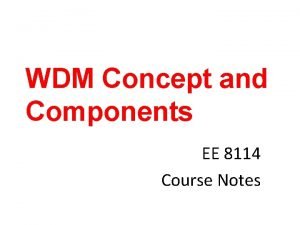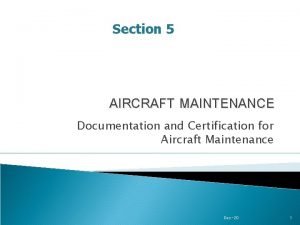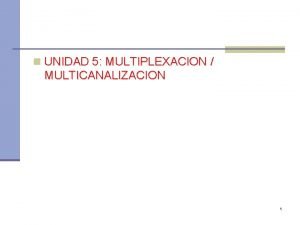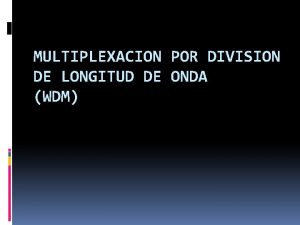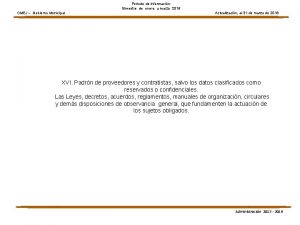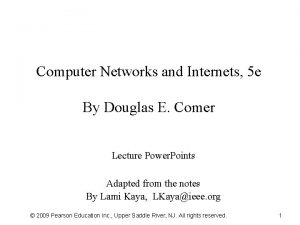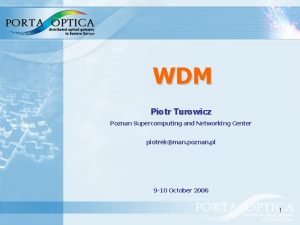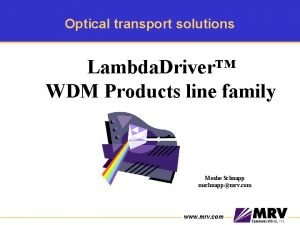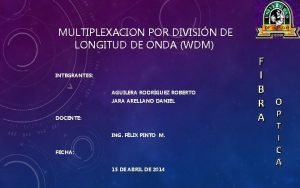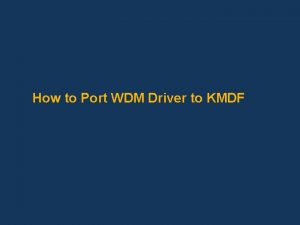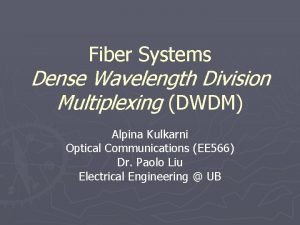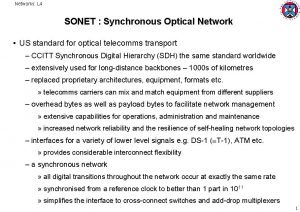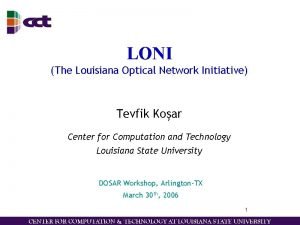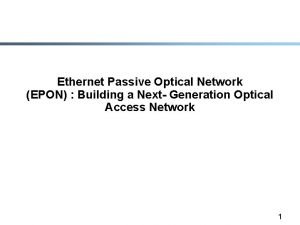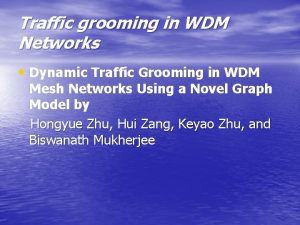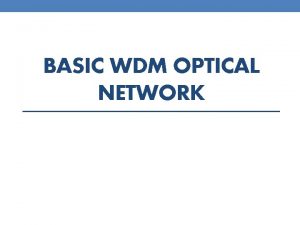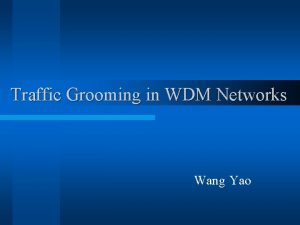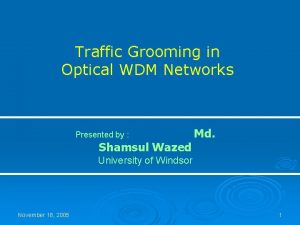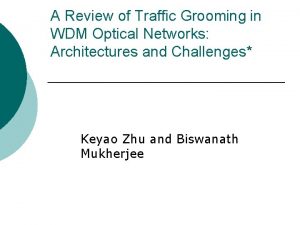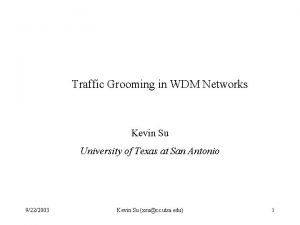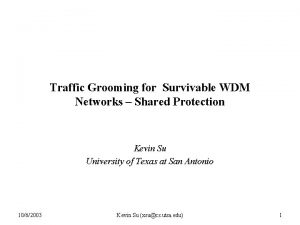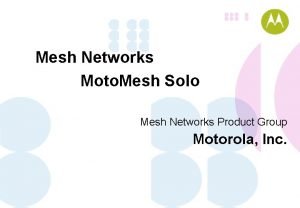Traffic Grooming in an Optical WDM Mesh Network




























- Slides: 28

Traffic Grooming in an Optical WDM Mesh Network Towsif Mannan CEG 790 Winter 2003 mannan. 2@wright. edu

Overview • • Defining the Traffic Grooming Problem Related Terms ILP Formulation of the Problem Heuristic Approach to the Problem Results and Findings Extension for Network Revenue Model Conclusion

Traffic Grooming Problem • The Highway Analogy • Sharing Lightpath Capacity • Virtual Paths

Illustrative Example 1 λ 0 2 0 Receiver λ 1 5 Transmitter 3 4 Receiver

Example cont…

Related Terms • Wavelength Routing Switches • Add-Drop Multiplexers • SONET Ring Network

Cont. • The Node

Problem Formulation • Physical Topology Gp = (V, Ep) V = Set of Network Node Ep = Set of Physical Link • W = # of Wavelength Channels Carried by each fiber • C = Capacity of a Channel • Set of N * N Traffic Matrices • TRi = # of Transmitters at a Node • RRi = # of Receivers at a Node

The Goals • A Virtual Topology Gv = (V, Ev) • Minimize Total Network Cost OR • Maximize Total Throughput We Consider Maximizing Throughput

Assumptions • • • Network is a Single Fiber Irregular Mesh No Wavelength Conversion Transceivers are Tunable Connection Requests are NOT Dividable Unlimited Multiplexing/Demultiplexing Capability

ILP Formulation Maximize the Total Successfully-routed Low Speed Connection y = granularity of low-speed traffic requests: y={1, 3, 12, 48} = 1 if tth OC-y connection from S to D is successful

ILP Formulation cont… For Multi-Hop Traffic Grooming Constraints: • # of lightpaths between (i, j) is less than or equal to # of transmitters and # of receivers • Lightpaths between (i, j) are composed of lightpaths on different wavelengths between (i, j) • Flow Conservation is Maintained

ILP Formulation cont… • A Wavelength Can Only be Present Once on One Lightpath in a Fiber Link (m, n) • Aggregate Traffic Flowing Through Lightpath Cannot Exceed the Overall Channel Capacity

ILP Formulation cont… Single-Hop Traffic Grooming • Connection Can only Traverse One Lightpath

Example Network

ILP Results

ILP Result cont…

Heuristic Approach • Determine the # of Lightpaths Between Any Node Pair • Route the Lightpaths Over the Physical Topology • Assign Wavelengths Optimally to the Lightpaths • Route the Low-Speed Connection requests On the Virtual Topology

Heuristic Approach cont… • Maximizing Single-hop Traffic (MST) • Maximizing Resource Utilization (MRU)

Heuristic Approach cont… Step 1: Construct virtual topology 1. 1 Sort all of the node pairs according to the sum of uncarried traffic request T(s, d) between (s, d) and put them into a list L in descending order.

Heuristic Approach cont… 1. 2: Try to setup a lightpath between the first node pair (s’, d’) in L using first-fit wavelength assignment and shortest-path routing. If it fails, delete (s’, d’) from L; otherwise let T(s, d)= Max[T(s, d)-C, 0] and go to Step 1. 1 until L is empty

Heuristic Approach cont… Step 2: Route the low-speed connections of the virtual topology constructed in Step 1. 2. 1: Satisfy all of the connection requests which can be carried though single lightpath hop, and update the virtual topology network state.

Heuristic Approach cont… 2. 2: Route the remaining connection requests based on the current virtual topology network state, in the decending order of the connections’ bandwidth requirement.

Heuristic Approach cont… Maximizing Resource Utilization Connection Resource Utilization Value T(s, d)/H(s, d) t(s, d)/H’(s, d) T(s, d)= Aggregate traffic between s and d t(s, d)= One connection request between s and d

Result Comparison

Extension for Network Revenue Model Maximize Network Revenue dsd = Distance between S and D = Quantity discount in capacity cost

Comparison Between Revenue Model and Network Throughput Model

Conclusion • • • Defining the Traffic Grooming Problem Related Terms ILP Formulation of the Problem Heuristic Approach to the Problem Results and Findings Extension for Network Revenue Model
 Optical mesh network
Optical mesh network Constant mesh gear box
Constant mesh gear box Wdm network
Wdm network Ftコミュニケーションズ 交換機
Ftコミュニケーションズ 交換機 Inbound traffic vs outbound traffic
Inbound traffic vs outbound traffic Intelligent traffic solutions
Intelligent traffic solutions Sky q mesh network diagram
Sky q mesh network diagram Iskxxosj
Iskxxosj Meshnet: mesh neural network for 3d shape representation
Meshnet: mesh neural network for 3d shape representation Outdoor wireless mesh network design
Outdoor wireless mesh network design Ubnt link calc
Ubnt link calc Star mesh network
Star mesh network Amateur radio mesh network
Amateur radio mesh network Wdm concept
Wdm concept Wdm concept
Wdm concept Aircraft reliability program manual
Aircraft reliability program manual Tdm wdm fdm
Tdm wdm fdm Multiplexación por división de longitud de onda (wdm)
Multiplexación por división de longitud de onda (wdm) Wdm 990126350
Wdm 990126350 Fdm tdm wdm in computer networks
Fdm tdm wdm in computer networks Wdm ring
Wdm ring Wdm
Wdm Optical transport solutions
Optical transport solutions Wdm
Wdm Wdfrequestretrieveinputmemory
Wdfrequestretrieveinputmemory Fiber optic wdm
Fiber optic wdm Sonet synchronous optical network
Sonet synchronous optical network Loni pop
Loni pop Gigabit ethernet passive optical network
Gigabit ethernet passive optical network

